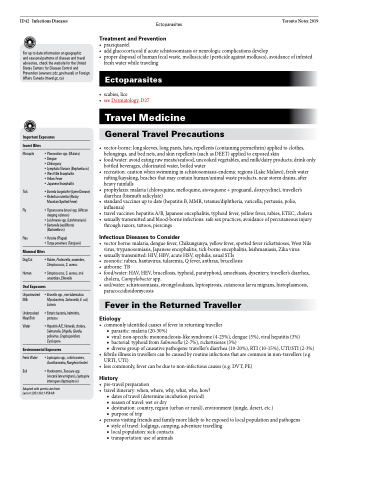Page 642 - TNFlipTest
P. 642
ID42 Infectious Diseases
Ectoparasites Toronto Notes 2019
Treatment and Prevention
• praziquantel
• addglucocorticoidifacuteschistosomiasisorneurologiccomplicationsdevelop
• properdisposalofhumanfecalwaste,molluscicide(pesticideagainstmolluscs),avoidanceofinfested
fresh water while traveling
Ectoparasites
• scabies, lice
• seeDermatology,D27
Travel Medicine
General Travel Precautions
• vector-borne:longsleeves,longpants,hats,repellents(containingpermethrin)appliedtoclothes, belongings, and bed nets, and skin repellents (such as DEET) applied to exposed skin
• food/water:avoideatingrawmeats/seafood,uncookedvegetables,andmilk/dairyproducts;drinkonly bottled beverages, chlorinated water, boiled water
• recreation:cautionwhenswimminginschistosomiasis-endemicregions(LakeMalawi),freshwater rafting/kayaking, beaches that may contain human/animal waste products, near storm drains, after heavy rainfalls
• prophylaxis:malaria(chloroquine,mefloquine,atovaquone+proguanil,doxycycline),traveller’s diarrhea (bismuth salicylate)
• standard vaccines up to date (hepatitis B, MMR, tetanus/diphtheria, varicella, pertussis, polio, influenza)
• travelvaccines:hepatitisA/B,Japaneseencephalitis,typhoidfever,yellowfever,rabies,ETEC,cholera • sexually transmitted and blood-borne infections: safe sex practices, avoidance of percutaneous injury
through razors, tattoos, piercings
Infectious Diseases to Consider
• vectorborne:malaria,denguefever,Chikungunya,yellowfever,spottedfeverrickettsioses,WestNile virus, trypanosomiasis, Japanese encephalitis, tick-borne encephalitis, leishmaniasis, Zika virus
• sexuallytransmitted:HIV,HBV,acuteHSV,syphilis,usualSTIs
• zoonotic:rabies,hantavirus,tularemia,Qfever,anthrax,brucellosis
• airborne: TB
• food/water: HAV, HEV, brucellosis, typhoid, paratyphoid, amoebiasis, dysentery, traveller’s diarrhea,
cholera, Campylobacter spp.
• soil/water:schistosomiasis,strongyloidiasis,leptospirosis,cutaneouslarvamigrans,histoplasmosis,
paracoccidioidomycosis
Fever in the Returned Traveller
Etiology
• commonlyidentifiedcausesoffeverinreturningtraveller
■ parasitic: malaria (20-30%)
■ viral: non-specific mononucleosis-like syndrome (4-25%), dengue (5%), viral hepatitis (3%)
■ bacterial: typhoid from Salmonella (2-7%), rickettsioses (3%)
■ diverse group of causative pathogens: traveller’s diarrhea (10-20%), RTI (10-15%), UTI/STI (2-3%)
• febrileillnessintravellerscanbecausedbyroutineinfectionsthatarecommoninnon-travellers(e.g. URTI, UTI)
• lesscommonly,fevercanbeduetonon-infectiouscauses(e.g.DVT,PE)
History
• pre-travelpreparation
• travel itinerary: when, where, why, what, who, how?
■ dates of travel (determine incubation period)
■ season of travel: wet or dry
■ destination: country, region (urban or rural), environment (jungle, desert, etc.) ■ purpose of trip
• personsvisitingfriendsandfamilymorelikelytobeexposedtolocalpopulationandpathogens ■ style of travel: lodgings, camping, adventure travelling
■ local population: sick contacts
■ transportation: use of animals
For up to date information on geographic
and seasonal patterns of disease and travel advisories, check the website for the United States Centers for Disease Control and Prevention (wwwnc.cdc.gov/travel) or Foreign Affairs Canada (travel.gc.ca)
Important Exposures
Insect Bites
Mosquito • Plasmodium spp. (Malaria) • Dengue
• Chikunguny
• Lymphatic filariasis (Elephantiasis) • West Nile Encephalitis
• Yellow Fever
• Japanese Encephalitis
Tick • Borrelia burgdorferi (Lyme Disease) • Rickettsia rickettsii (Rocky
Mountain Spotted Fever)
Fly • Trypanosoma brucei spp. (African sleeping sickness)
• Leishmania spp. (Leishmaniasis) • Bartonella bacilliformis
(Bartonellosis) Flea • Yersinia (Plague)
• Tunga penetrans (Tungiasis)
Mammal Bites
Dog/Cat • Rabies, Pasteurella, anaerobes, Streptococcus, S. aureus
Human • Streptococcus, S. aureus, oral anaerobes, Eikenella
Oral Exposures
Unpasteurized Milk
Undercooked Meat/Fish
Water
• Brucella spp., non-tuberculous Mycobacteria, Salmonella, E. coli, Listeria
• Enteric bacteria, helminths, protozoa
• Hepatitis A/E, Norwalk, cholera, Salmonella, Shigella, Giardia, poliovirus, Cryptosporidium, Cyclospora
Environmental Exposures
Fresh Water Soil
• Leptospira spp., schistosomes, Acanthamoeba, Naegleria fowleri
• Hookworms, Toxocara spp. (visceral larva migrans), Leptospira interrogans (leptospirosis)
Adapted with permission from Lancet 2003;361:1459-69


